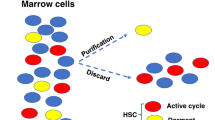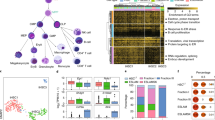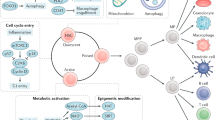Haemopoietic stem cells are organised for use on the basis of their generation-age (original) (raw)
- Letter
- Published: 04 November 1976
Nature volume 264, pages 68–69 (1976)Cite this article
- 90 Accesses
- 43 Citations
- 3 Altmetric
- Metrics details
Abstract
THE spleen-colony assay of Till and McCulloch1, which is a clonal assay2, measures the content of haemopoietic cells in blood-forming tissues. Stem cells (colony forming units in spleen, CPUS) form red cells, granulocytes, platelets and themselves (self-renewal) in these colonies3,4. Worton _et al._5 reported that stem cells separated by velocity sedimentation differed in their capacity for self-renewal. Schofield and Lajtha6 reported that CPUS from mice treated with iso-propyl methane sulphonate have a low self-renewal capacity. We have studied the functional capacity of myeloid stem cells from normal mice (NBM) and mice treated with hydroxyurea. CPUS from mice treated with five injections of hydroxyurea (5 HUBM, G.S.H. and N. M. Blackett, unpublished) formed 3 times more CPUS and 2.5 times more colony forming units in culture per original colony (CFUC, a committed precursor of granulopoiesis7) than those from NBM. When these grafted CPUS were retransplanted they still formed three times more CFUC and CPUS per secondary colony than those from NBM (Tables 1 and 2).
This is a preview of subscription content, access via your institution
Access options
Subscribe to this journal
Receive 51 print issues and online access
$199.00 per year
only $3.90 per issue
Buy this article
- Purchase on SpringerLink
- Instant access to full article PDF
Prices may be subject to local taxes which are calculated during checkout
Additional access options:
Similar content being viewed by others

The universal stem cell
Article Open access 28 October 2022


References
- Till, J. E., and McCulloch, E. A., Rad. Res., 14, 213–222 (1961).
Article CAS Google Scholar - Becker, A. J., McCulloch, E. A., and Till, J. E., Nature, 197, 452–454 (1963).
Article ADS CAS Google Scholar - Fowler, J. H., Wu, A. M., Till, J. E., McCulloch, E. A., and Siminovitch, L., J. Cell Physiol., 69, 65–72 (1967).
Article Google Scholar - McCulloch, E. A., and Till, J. E., Rad. Res., 22, 383–397 (1963).
Article Google Scholar - Worton, R. G., McCulloch, E. A., and Till, J. E., J. exp. Med., 130, 91–103 (1969).
Article CAS Google Scholar - Schofield, R., and Lajtha, L. G., Br. J. Haemat., 25, 195–202 (1973).
Article CAS Google Scholar - Bradley, T. R., and Metcalf, D., Aust. J. exp. Biol. Med. Sci., 44, 287–300 (1966).
Article CAS Google Scholar - Hodgson, G. S., Bradley, T. R., Martin, R. F., Sumner, M., and Fry, P., Cell Tissue Kinet., 8, 51–60 (1975).
CAS PubMed Google Scholar - Hodgson, G. S., Bradley, T. R., and Telfer, P. A., Cell Tissue Kinet., 5, 283–288 (1972).
CAS PubMed Google Scholar
Author information
Authors and Affiliations
- Biological Research Unit, Cancer Institute, 481 Little Lonsdale Street, Melbourne, 3000, Australia
MARTIN ROSENDAAL, G. S. HODGSON & T. R. BRADLEY
Authors
- MARTIN ROSENDAAL
You can also search for this author inPubMed Google Scholar - G. S. HODGSON
You can also search for this author inPubMed Google Scholar - T. R. BRADLEY
You can also search for this author inPubMed Google Scholar
Rights and permissions
About this article
Cite this article
ROSENDAAL, M., HODGSON, G. & BRADLEY, T. Haemopoietic stem cells are organised for use on the basis of their generation-age.Nature 264, 68–69 (1976). https://doi.org/10.1038/264068a0
- Received: 09 July 1976
- Accepted: 13 September 1976
- Issue Date: 04 November 1976
- DOI: https://doi.org/10.1038/264068a0